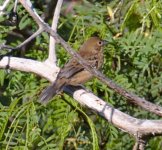
Fair enough. Go to this page, scroll down and follow the link to the gallery using the yellow bar: https://www.birdforum.net/opus/Blue-black_Grassquit
To mention one thing, I do not see a single female colored bird with a pale eye-ring like on the op bird. I have more difficulty in describing what I feel is a difference in the spotting/stripes on the underside.
Disclaimer: during the last many years I have seen many more grassquits than buntings.
Niels
Niels
To mention one thing, I do not see a single female colored bird with a pale eye-ring like on the op bird. I have more difficulty in describing what I feel is a difference in the spotting/stripes on the underside.
Disclaimer: during the last many years I have seen many more grassquits than buntings.
Niels
Niels





